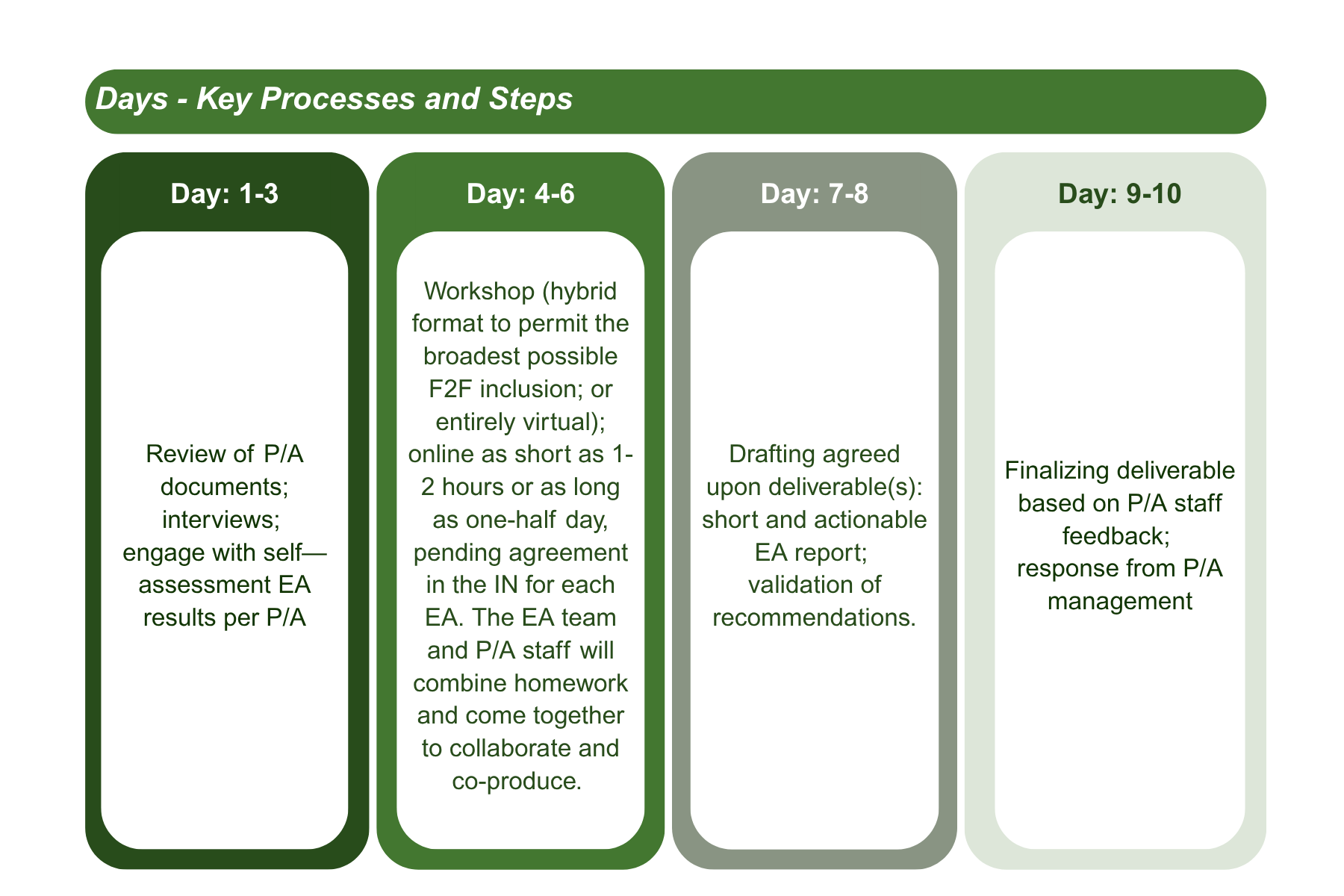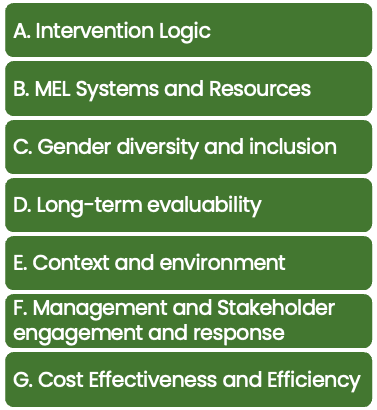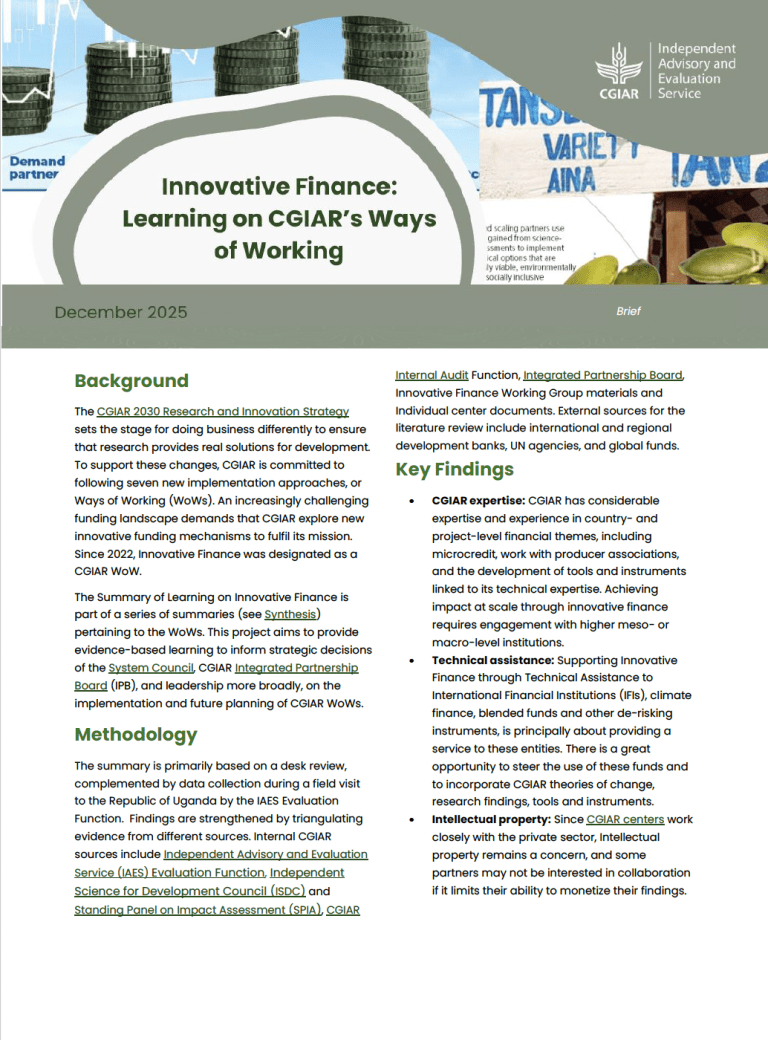The CGIAR 2025-2030 Portfolio Evaluability Assessments
As CGIAR launches its new research Portfolio for 2025–2030, ensuring that each program and accelerator is ready for robust, credible evaluation is more important than ever. That’s where the Evaluability Assessments (EAs) come in. Led by the Independent Advisory and Evaluation Service (IAES), these assessments provide actionable recommendations to strengthen monitoring, evaluation, learning, and impact assessment (MELIA) systems across the Portfolio. Conducted in three phases, the 2025 EAs will set the stage for midline evaluations in 2027—offering key insights to improve program design, track progress, and enhance CGIAR’s contribution to global development goals.
Explore the most frequently asked questions below to learn more about their purpose, process, and value for CGIAR programs.
What is the purpose and expected outputs of these Evaluability Assessments (EAs)?
The Evaluability Assessment (EA) aims to provide actionable recommendations for improved MELIA components for each of the programs and accelerators (P/As), while preparing the Portfolio for midline evaluations in 2027. Both the EA and mid-line evaluations of CGIAR’s 2025-30 Portfolio are included in the 2025-27 work plan for CGIAR's Independent Advisory and Evaluation Service (IAES) (SC/M21/DP5), and have been approved by the System Council. An update on the EA process was shared at SC22 (link).
Who are key stakeholders in the EAs?
Key stakeholders include program and accelerator staff, implementing and any supported communities. Donors and CGIAR management, including PPU and PCU, are also key stakeholders.
How coordinated is the EA process with the ISDC reviews and the PPU and the PCU?
In line with the 2025 EA Terms of Reference, in April-May, the EA partially assessed Individual P/A draft ToC and MELIA Plans (shared with PPU on 23 May). The partial EA applied Domains A and B from the EA framework (Figure 1) referencing the 2023 EAs of the Regional Integrated Initiatives (RIIs) (link). They were cross-referenced with the EA initial review of PPU’s guidance on ToCs and MELIA plans. The EA presented to ISDC reviewers as part of their induction for the review of P/A Inception Reports (link). ISDC reviews are one of key documents for the full EA in August-October 2025.
How will the EAs of the Portfolio be implemented?
The IAES’ EA Guidelines (also in Spanish) under the CGIAR-wide Evaluation Framework is the primary resource for the EA process. The EA framework includes six core domains, with seventh – focused on cost and efficiency (Figure 1) – added at the funders’ request. Each domain is supported by guiding questions to inform implementation.
The EAs support the inception of the 2025-2030 Portfolio, and are conducted in three phases: inception, implementation and synthesis (for submission to the SC23). The inception phase (March-July) included document reviews and data collection, and a light-touch application of the EA Framework to support the development of the P/A Inception Report. The inception phase concludes with EA Inception Notes for each P/A, developed in collaboration with their teams to guide the approximately 10-day implementation phase (Table 1). The EA process would: validate the EA purpose; confirm and involve stakeholders; apply the EA Framework; engage the P/As (aka evaluand) through interviews and self-assessment (survey distributed by July 30th) to collect key documents and identify potential evidence gaps; decide on evaluation readiness and make recommendations (e.g., in preparation for 2027 mid-line evaluations of P/As); and use EA results (for the inception and roll-out in 2027). Final EA reports will build on ISDC’s review of the Inception Reports.
Table 1. Estimated iterative 10-day implementation per Science Program/Accelerator

Who is conducting the EAs?
The core EA team includes IAES staff and consultants: a Team Lead evaluation consultant experienced in EAs, and a subject matter expert, with additional thematic expertise provided per P/A. To facilitate participation, strengthen program understanding, and build capacity, each program’s CGIAR MEL focal point has been engaged and invited to join the EA team.
What is the level of effort required from the P/A staff for this exercise?
The EA implementation phase of the full EA Framework will be detailed in the Inception Notes for each of the 13 P/As (Table 1). The EA workplan will be tailored and iterative, with timelines reflecting scheduling demands, agreed level of effort, and coordination among the EA Team and the P/A staff.
What is evaluability?
At CGIAR, evaluability is defined as “the extent to which an intervention can be evaluated in a reliable and credible fashion” (CGIAR Evaluation Framework, p. 1). The concept of evaluability is regarded as central to fostering a culture of results. While the evaluability of a program can be assessed at any stage in the project cycle, focus on evaluability at the design and inception stage will prepare for overall ‘measurability’, monitoring and subsequent evaluation.
Why are EAs important for programs?
An EA prepares programs for evaluation to ensure that program goals are agreed on, information needs are well-defined, evaluation data are obtainable, and intended users are willing to use evaluation results.
What is an evaluation?
The most widely accepted definition of evaluation is by theorist Michael Scriven (1991): “Evaluation is the systematic process to determine merit, worth, value or significance” of the evaluand, or that which is being evaluated (p. 139). - thereby emphasizing the role of values in evaluation.
Learn more
- FAQ: Evaluation and Evaluability Assessments (EA)
- Evaluability Assessments Resource Hub
- Blog: Evaluability Assessments are an Essential New Tool for CGIAR Managers
Reference:
Scriven, M. (1991). Evaluation Thesaurus (4th edition). Sage Publications.
Download the brief (PDF) with all the information included in this article here: https://iaes.cgiar.org/publications/2025-evaluability-assessments-eas-everything-you-need-know




